Construction Technology Report: Analysis of Hotel Construction in UK
VerifiedAdded on 2020/12/18
|17
|5726
|356
Report
AI Summary
This report provides a comprehensive analysis of construction technology, focusing on the development of a complex hotel in the UK. It begins with an introduction to construction technology, differentiating between residential, commercial, and industrial buildings. The report then delves into the specifics of substructures, including the types of information needed for foundation design, sustainability considerations, and the impact of site information. Superstructures are also examined, with a focus on functional characteristics and pre-design studies. Furthermore, the report explores civil engineering infrastructure, including remediation techniques and types of substructure works. Finally, it addresses building services, covering supply and distribution arrangements, and the elements of the superstructure that facilitate these services. The report highlights the importance of sustainable building practices and provides insights into various terminologies used in construction technology.
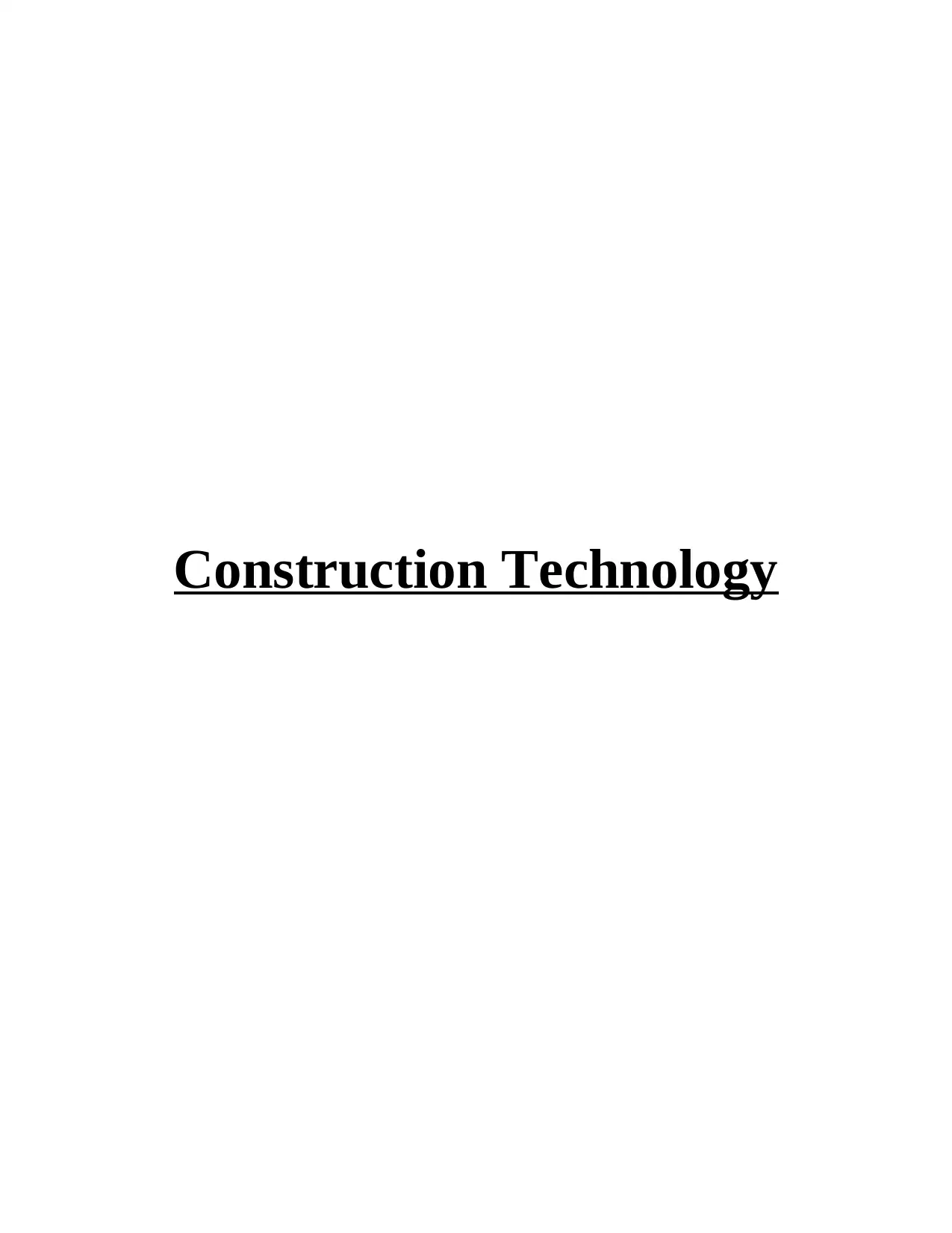
Construction Technology
Paraphrase This Document
Need a fresh take? Get an instant paraphrase of this document with our AI Paraphraser
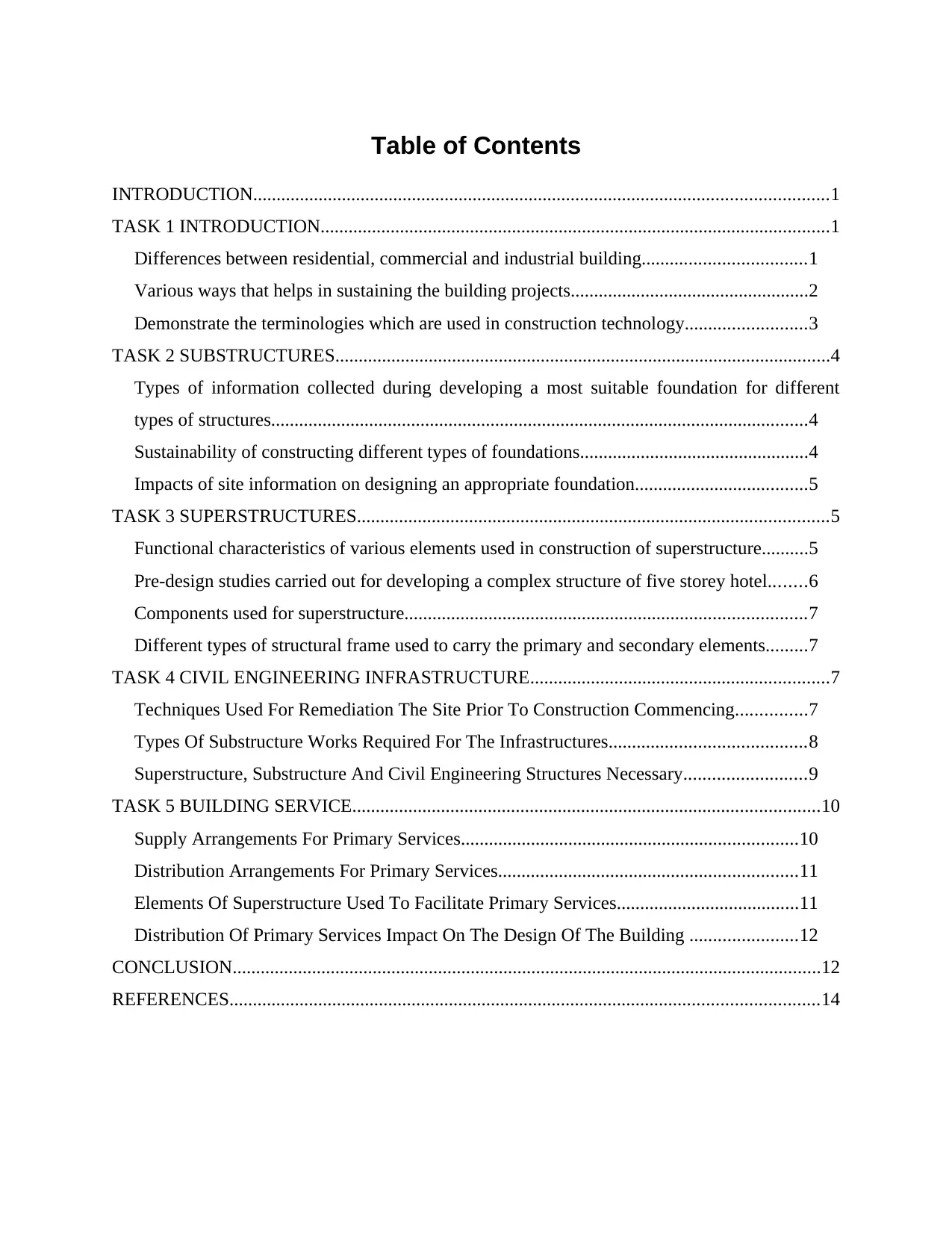
Table of Contents
INTRODUCTION...........................................................................................................................1
TASK 1 INTRODUCTION.............................................................................................................1
Differences between residential, commercial and industrial building...................................1
Various ways that helps in sustaining the building projects...................................................2
Demonstrate the terminologies which are used in construction technology..........................3
TASK 2 SUBSTRUCTURES..........................................................................................................4
Types of information collected during developing a most suitable foundation for different
types of structures...................................................................................................................4
Sustainability of constructing different types of foundations.................................................4
Impacts of site information on designing an appropriate foundation.....................................5
TASK 3 SUPERSTRUCTURES.....................................................................................................5
Functional characteristics of various elements used in construction of superstructure..........5
Pre-design studies carried out for developing a complex structure of five storey hotel........6
Components used for superstructure......................................................................................7
Different types of structural frame used to carry the primary and secondary elements.........7
TASK 4 CIVIL ENGINEERING INFRASTRUCTURE................................................................7
Techniques Used For Remediation The Site Prior To Construction Commencing...............7
Types Of Substructure Works Required For The Infrastructures..........................................8
Superstructure, Substructure And Civil Engineering Structures Necessary..........................9
TASK 5 BUILDING SERVICE....................................................................................................10
Supply Arrangements For Primary Services........................................................................10
Distribution Arrangements For Primary Services................................................................11
Elements Of Superstructure Used To Facilitate Primary Services.......................................11
Distribution Of Primary Services Impact On The Design Of The Building .......................12
CONCLUSION..............................................................................................................................12
REFERENCES..............................................................................................................................14
INTRODUCTION...........................................................................................................................1
TASK 1 INTRODUCTION.............................................................................................................1
Differences between residential, commercial and industrial building...................................1
Various ways that helps in sustaining the building projects...................................................2
Demonstrate the terminologies which are used in construction technology..........................3
TASK 2 SUBSTRUCTURES..........................................................................................................4
Types of information collected during developing a most suitable foundation for different
types of structures...................................................................................................................4
Sustainability of constructing different types of foundations.................................................4
Impacts of site information on designing an appropriate foundation.....................................5
TASK 3 SUPERSTRUCTURES.....................................................................................................5
Functional characteristics of various elements used in construction of superstructure..........5
Pre-design studies carried out for developing a complex structure of five storey hotel........6
Components used for superstructure......................................................................................7
Different types of structural frame used to carry the primary and secondary elements.........7
TASK 4 CIVIL ENGINEERING INFRASTRUCTURE................................................................7
Techniques Used For Remediation The Site Prior To Construction Commencing...............7
Types Of Substructure Works Required For The Infrastructures..........................................8
Superstructure, Substructure And Civil Engineering Structures Necessary..........................9
TASK 5 BUILDING SERVICE....................................................................................................10
Supply Arrangements For Primary Services........................................................................10
Distribution Arrangements For Primary Services................................................................11
Elements Of Superstructure Used To Facilitate Primary Services.......................................11
Distribution Of Primary Services Impact On The Design Of The Building .......................12
CONCLUSION..............................................................................................................................12
REFERENCES..............................................................................................................................14
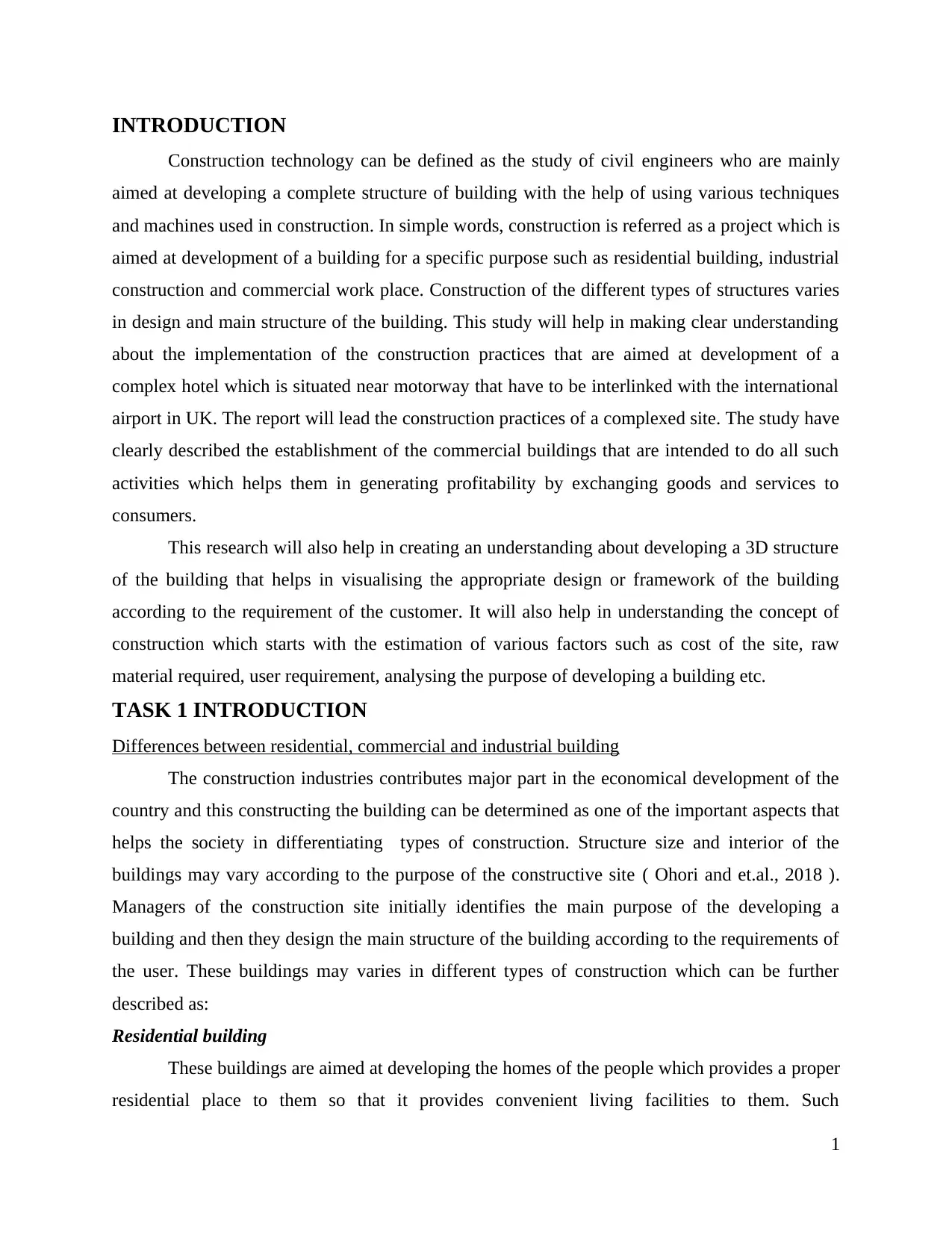
INTRODUCTION
Construction technology can be defined as the study of civil engineers who are mainly
aimed at developing a complete structure of building with the help of using various techniques
and machines used in construction. In simple words, construction is referred as a project which is
aimed at development of a building for a specific purpose such as residential building, industrial
construction and commercial work place. Construction of the different types of structures varies
in design and main structure of the building. This study will help in making clear understanding
about the implementation of the construction practices that are aimed at development of a
complex hotel which is situated near motorway that have to be interlinked with the international
airport in UK. The report will lead the construction practices of a complexed site. The study have
clearly described the establishment of the commercial buildings that are intended to do all such
activities which helps them in generating profitability by exchanging goods and services to
consumers.
This research will also help in creating an understanding about developing a 3D structure
of the building that helps in visualising the appropriate design or framework of the building
according to the requirement of the customer. It will also help in understanding the concept of
construction which starts with the estimation of various factors such as cost of the site, raw
material required, user requirement, analysing the purpose of developing a building etc.
TASK 1 INTRODUCTION
Differences between residential, commercial and industrial building
The construction industries contributes major part in the economical development of the
country and this constructing the building can be determined as one of the important aspects that
helps the society in differentiating types of construction. Structure size and interior of the
buildings may vary according to the purpose of the constructive site ( Ohori and et.al., 2018 ).
Managers of the construction site initially identifies the main purpose of the developing a
building and then they design the main structure of the building according to the requirements of
the user. These buildings may varies in different types of construction which can be further
described as:
Residential building
These buildings are aimed at developing the homes of the people which provides a proper
residential place to them so that it provides convenient living facilities to them. Such
1
Construction technology can be defined as the study of civil engineers who are mainly
aimed at developing a complete structure of building with the help of using various techniques
and machines used in construction. In simple words, construction is referred as a project which is
aimed at development of a building for a specific purpose such as residential building, industrial
construction and commercial work place. Construction of the different types of structures varies
in design and main structure of the building. This study will help in making clear understanding
about the implementation of the construction practices that are aimed at development of a
complex hotel which is situated near motorway that have to be interlinked with the international
airport in UK. The report will lead the construction practices of a complexed site. The study have
clearly described the establishment of the commercial buildings that are intended to do all such
activities which helps them in generating profitability by exchanging goods and services to
consumers.
This research will also help in creating an understanding about developing a 3D structure
of the building that helps in visualising the appropriate design or framework of the building
according to the requirement of the customer. It will also help in understanding the concept of
construction which starts with the estimation of various factors such as cost of the site, raw
material required, user requirement, analysing the purpose of developing a building etc.
TASK 1 INTRODUCTION
Differences between residential, commercial and industrial building
The construction industries contributes major part in the economical development of the
country and this constructing the building can be determined as one of the important aspects that
helps the society in differentiating types of construction. Structure size and interior of the
buildings may vary according to the purpose of the constructive site ( Ohori and et.al., 2018 ).
Managers of the construction site initially identifies the main purpose of the developing a
building and then they design the main structure of the building according to the requirements of
the user. These buildings may varies in different types of construction which can be further
described as:
Residential building
These buildings are aimed at developing the homes of the people which provides a proper
residential place to them so that it provides convenient living facilities to them. Such
1
⊘ This is a preview!⊘
Do you want full access?
Subscribe today to unlock all pages.

Trusted by 1+ million students worldwide
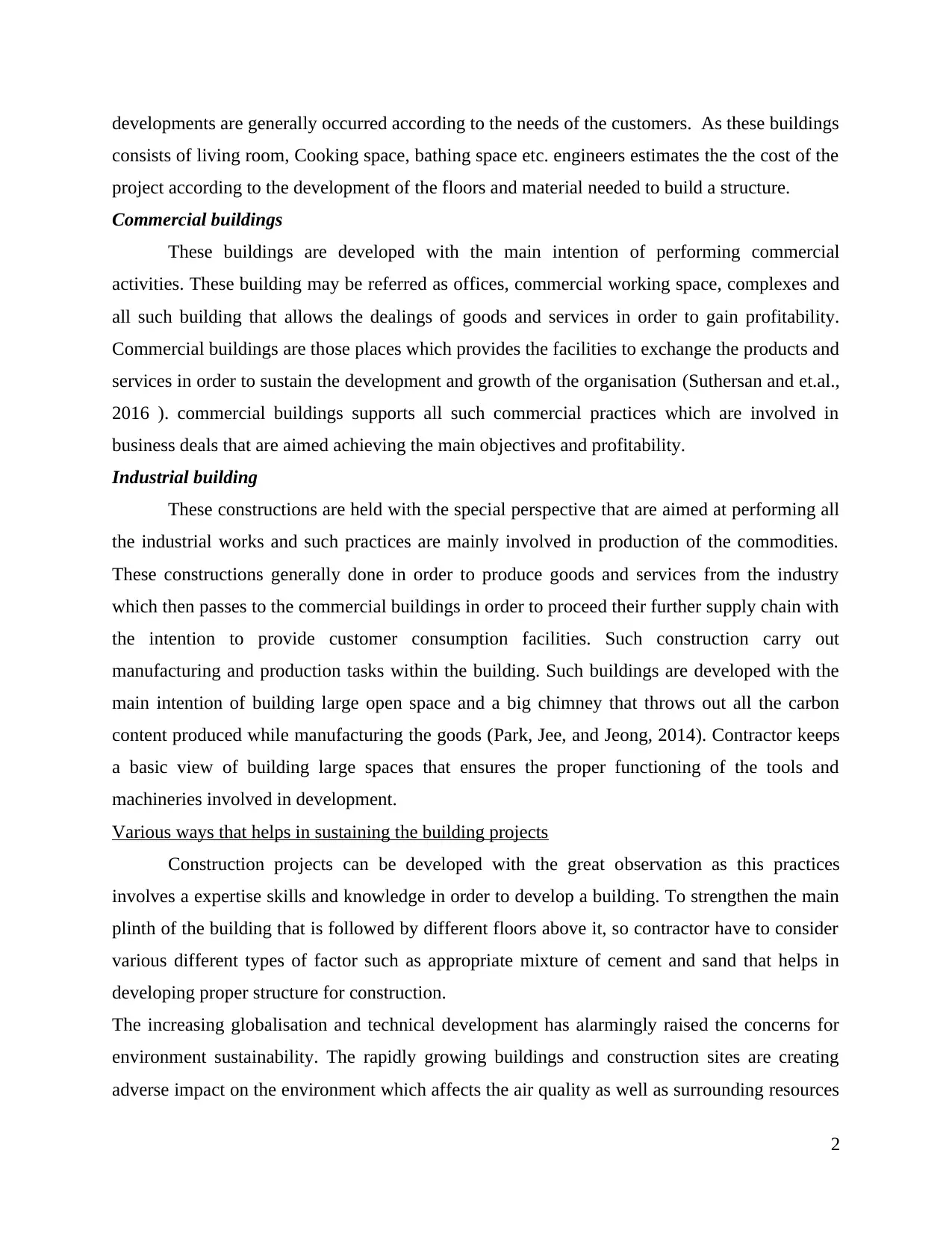
developments are generally occurred according to the needs of the customers. As these buildings
consists of living room, Cooking space, bathing space etc. engineers estimates the the cost of the
project according to the development of the floors and material needed to build a structure.
Commercial buildings
These buildings are developed with the main intention of performing commercial
activities. These building may be referred as offices, commercial working space, complexes and
all such building that allows the dealings of goods and services in order to gain profitability.
Commercial buildings are those places which provides the facilities to exchange the products and
services in order to sustain the development and growth of the organisation (Suthersan and et.al.,
2016 ). commercial buildings supports all such commercial practices which are involved in
business deals that are aimed achieving the main objectives and profitability.
Industrial building
These constructions are held with the special perspective that are aimed at performing all
the industrial works and such practices are mainly involved in production of the commodities.
These constructions generally done in order to produce goods and services from the industry
which then passes to the commercial buildings in order to proceed their further supply chain with
the intention to provide customer consumption facilities. Such construction carry out
manufacturing and production tasks within the building. Such buildings are developed with the
main intention of building large open space and a big chimney that throws out all the carbon
content produced while manufacturing the goods (Park, Jee, and Jeong, 2014). Contractor keeps
a basic view of building large spaces that ensures the proper functioning of the tools and
machineries involved in development.
Various ways that helps in sustaining the building projects
Construction projects can be developed with the great observation as this practices
involves a expertise skills and knowledge in order to develop a building. To strengthen the main
plinth of the building that is followed by different floors above it, so contractor have to consider
various different types of factor such as appropriate mixture of cement and sand that helps in
developing proper structure for construction.
The increasing globalisation and technical development has alarmingly raised the concerns for
environment sustainability. The rapidly growing buildings and construction sites are creating
adverse impact on the environment which affects the air quality as well as surrounding resources
2
consists of living room, Cooking space, bathing space etc. engineers estimates the the cost of the
project according to the development of the floors and material needed to build a structure.
Commercial buildings
These buildings are developed with the main intention of performing commercial
activities. These building may be referred as offices, commercial working space, complexes and
all such building that allows the dealings of goods and services in order to gain profitability.
Commercial buildings are those places which provides the facilities to exchange the products and
services in order to sustain the development and growth of the organisation (Suthersan and et.al.,
2016 ). commercial buildings supports all such commercial practices which are involved in
business deals that are aimed achieving the main objectives and profitability.
Industrial building
These constructions are held with the special perspective that are aimed at performing all
the industrial works and such practices are mainly involved in production of the commodities.
These constructions generally done in order to produce goods and services from the industry
which then passes to the commercial buildings in order to proceed their further supply chain with
the intention to provide customer consumption facilities. Such construction carry out
manufacturing and production tasks within the building. Such buildings are developed with the
main intention of building large open space and a big chimney that throws out all the carbon
content produced while manufacturing the goods (Park, Jee, and Jeong, 2014). Contractor keeps
a basic view of building large spaces that ensures the proper functioning of the tools and
machineries involved in development.
Various ways that helps in sustaining the building projects
Construction projects can be developed with the great observation as this practices
involves a expertise skills and knowledge in order to develop a building. To strengthen the main
plinth of the building that is followed by different floors above it, so contractor have to consider
various different types of factor such as appropriate mixture of cement and sand that helps in
developing proper structure for construction.
The increasing globalisation and technical development has alarmingly raised the concerns for
environment sustainability. The rapidly growing buildings and construction sites are creating
adverse impact on the environment which affects the air quality as well as surrounding resources
2
Paraphrase This Document
Need a fresh take? Get an instant paraphrase of this document with our AI Paraphraser
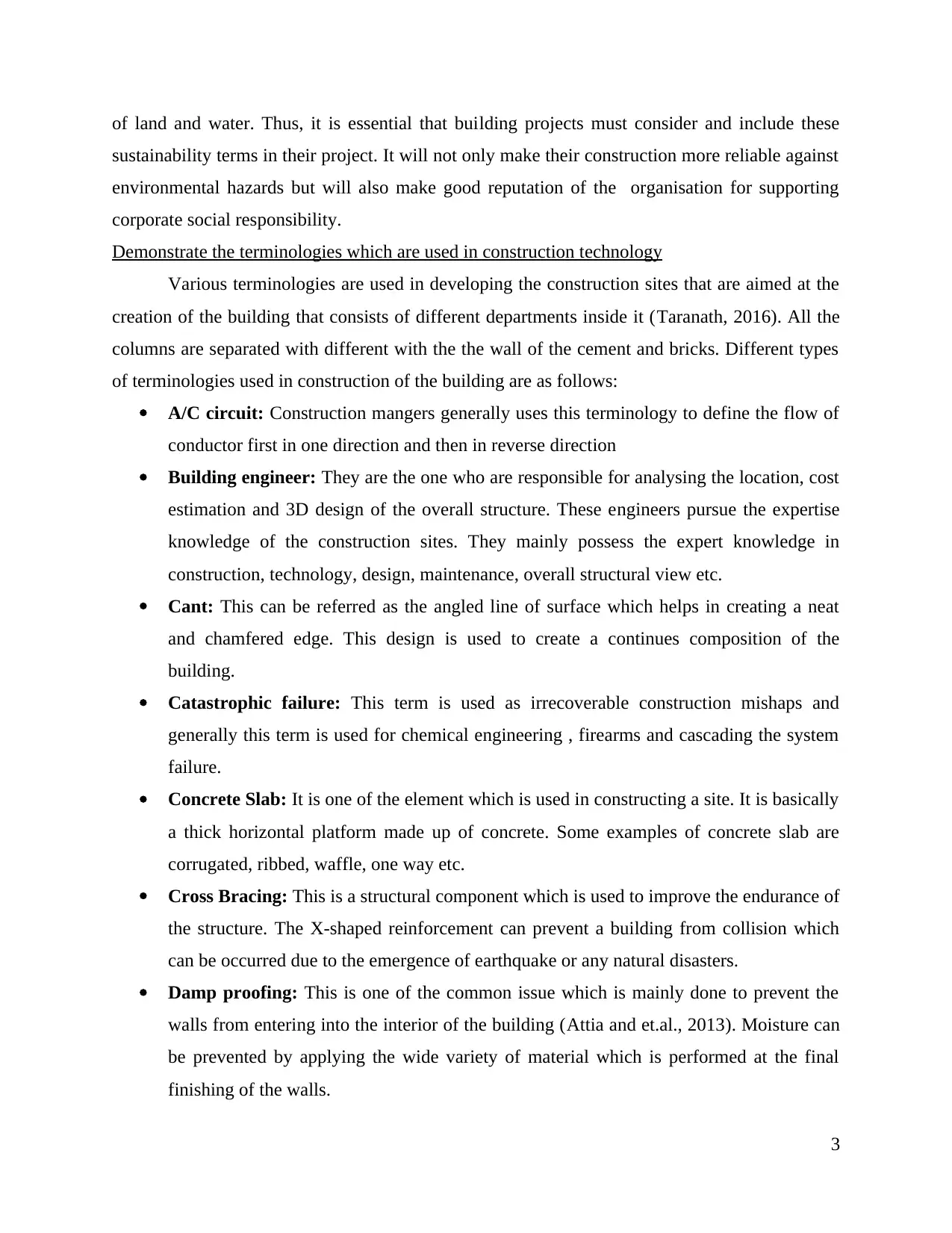
of land and water. Thus, it is essential that building projects must consider and include these
sustainability terms in their project. It will not only make their construction more reliable against
environmental hazards but will also make good reputation of the organisation for supporting
corporate social responsibility.
Demonstrate the terminologies which are used in construction technology
Various terminologies are used in developing the construction sites that are aimed at the
creation of the building that consists of different departments inside it (Taranath, 2016). All the
columns are separated with different with the the wall of the cement and bricks. Different types
of terminologies used in construction of the building are as follows:
A/C circuit: Construction mangers generally uses this terminology to define the flow of
conductor first in one direction and then in reverse direction
Building engineer: They are the one who are responsible for analysing the location, cost
estimation and 3D design of the overall structure. These engineers pursue the expertise
knowledge of the construction sites. They mainly possess the expert knowledge in
construction, technology, design, maintenance, overall structural view etc.
Cant: This can be referred as the angled line of surface which helps in creating a neat
and chamfered edge. This design is used to create a continues composition of the
building.
Catastrophic failure: This term is used as irrecoverable construction mishaps and
generally this term is used for chemical engineering , firearms and cascading the system
failure.
Concrete Slab: It is one of the element which is used in constructing a site. It is basically
a thick horizontal platform made up of concrete. Some examples of concrete slab are
corrugated, ribbed, waffle, one way etc.
Cross Bracing: This is a structural component which is used to improve the endurance of
the structure. The X-shaped reinforcement can prevent a building from collision which
can be occurred due to the emergence of earthquake or any natural disasters.
Damp proofing: This is one of the common issue which is mainly done to prevent the
walls from entering into the interior of the building (Attia and et.al., 2013). Moisture can
be prevented by applying the wide variety of material which is performed at the final
finishing of the walls.
3
sustainability terms in their project. It will not only make their construction more reliable against
environmental hazards but will also make good reputation of the organisation for supporting
corporate social responsibility.
Demonstrate the terminologies which are used in construction technology
Various terminologies are used in developing the construction sites that are aimed at the
creation of the building that consists of different departments inside it (Taranath, 2016). All the
columns are separated with different with the the wall of the cement and bricks. Different types
of terminologies used in construction of the building are as follows:
A/C circuit: Construction mangers generally uses this terminology to define the flow of
conductor first in one direction and then in reverse direction
Building engineer: They are the one who are responsible for analysing the location, cost
estimation and 3D design of the overall structure. These engineers pursue the expertise
knowledge of the construction sites. They mainly possess the expert knowledge in
construction, technology, design, maintenance, overall structural view etc.
Cant: This can be referred as the angled line of surface which helps in creating a neat
and chamfered edge. This design is used to create a continues composition of the
building.
Catastrophic failure: This term is used as irrecoverable construction mishaps and
generally this term is used for chemical engineering , firearms and cascading the system
failure.
Concrete Slab: It is one of the element which is used in constructing a site. It is basically
a thick horizontal platform made up of concrete. Some examples of concrete slab are
corrugated, ribbed, waffle, one way etc.
Cross Bracing: This is a structural component which is used to improve the endurance of
the structure. The X-shaped reinforcement can prevent a building from collision which
can be occurred due to the emergence of earthquake or any natural disasters.
Damp proofing: This is one of the common issue which is mainly done to prevent the
walls from entering into the interior of the building (Attia and et.al., 2013). Moisture can
be prevented by applying the wide variety of material which is performed at the final
finishing of the walls.
3
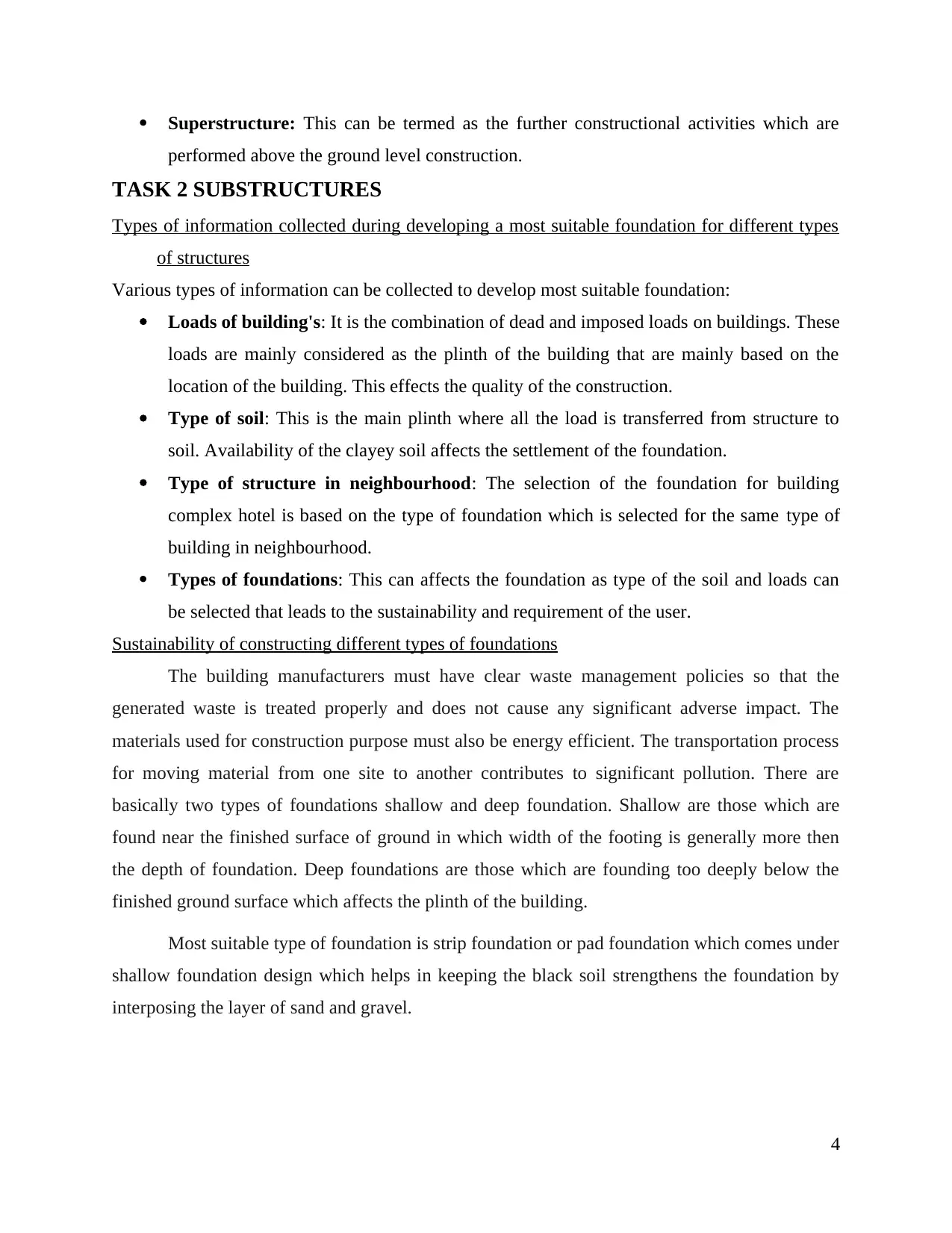
Superstructure: This can be termed as the further constructional activities which are
performed above the ground level construction.
TASK 2 SUBSTRUCTURES
Types of information collected during developing a most suitable foundation for different types
of structures
Various types of information can be collected to develop most suitable foundation:
Loads of building's: It is the combination of dead and imposed loads on buildings. These
loads are mainly considered as the plinth of the building that are mainly based on the
location of the building. This effects the quality of the construction.
Type of soil: This is the main plinth where all the load is transferred from structure to
soil. Availability of the clayey soil affects the settlement of the foundation.
Type of structure in neighbourhood: The selection of the foundation for building
complex hotel is based on the type of foundation which is selected for the same type of
building in neighbourhood.
Types of foundations: This can affects the foundation as type of the soil and loads can
be selected that leads to the sustainability and requirement of the user.
Sustainability of constructing different types of foundations
The building manufacturers must have clear waste management policies so that the
generated waste is treated properly and does not cause any significant adverse impact. The
materials used for construction purpose must also be energy efficient. The transportation process
for moving material from one site to another contributes to significant pollution. There are
basically two types of foundations shallow and deep foundation. Shallow are those which are
found near the finished surface of ground in which width of the footing is generally more then
the depth of foundation. Deep foundations are those which are founding too deeply below the
finished ground surface which affects the plinth of the building.
Most suitable type of foundation is strip foundation or pad foundation which comes under
shallow foundation design which helps in keeping the black soil strengthens the foundation by
interposing the layer of sand and gravel.
4
performed above the ground level construction.
TASK 2 SUBSTRUCTURES
Types of information collected during developing a most suitable foundation for different types
of structures
Various types of information can be collected to develop most suitable foundation:
Loads of building's: It is the combination of dead and imposed loads on buildings. These
loads are mainly considered as the plinth of the building that are mainly based on the
location of the building. This effects the quality of the construction.
Type of soil: This is the main plinth where all the load is transferred from structure to
soil. Availability of the clayey soil affects the settlement of the foundation.
Type of structure in neighbourhood: The selection of the foundation for building
complex hotel is based on the type of foundation which is selected for the same type of
building in neighbourhood.
Types of foundations: This can affects the foundation as type of the soil and loads can
be selected that leads to the sustainability and requirement of the user.
Sustainability of constructing different types of foundations
The building manufacturers must have clear waste management policies so that the
generated waste is treated properly and does not cause any significant adverse impact. The
materials used for construction purpose must also be energy efficient. The transportation process
for moving material from one site to another contributes to significant pollution. There are
basically two types of foundations shallow and deep foundation. Shallow are those which are
found near the finished surface of ground in which width of the footing is generally more then
the depth of foundation. Deep foundations are those which are founding too deeply below the
finished ground surface which affects the plinth of the building.
Most suitable type of foundation is strip foundation or pad foundation which comes under
shallow foundation design which helps in keeping the black soil strengthens the foundation by
interposing the layer of sand and gravel.
4
⊘ This is a preview!⊘
Do you want full access?
Subscribe today to unlock all pages.

Trusted by 1+ million students worldwide
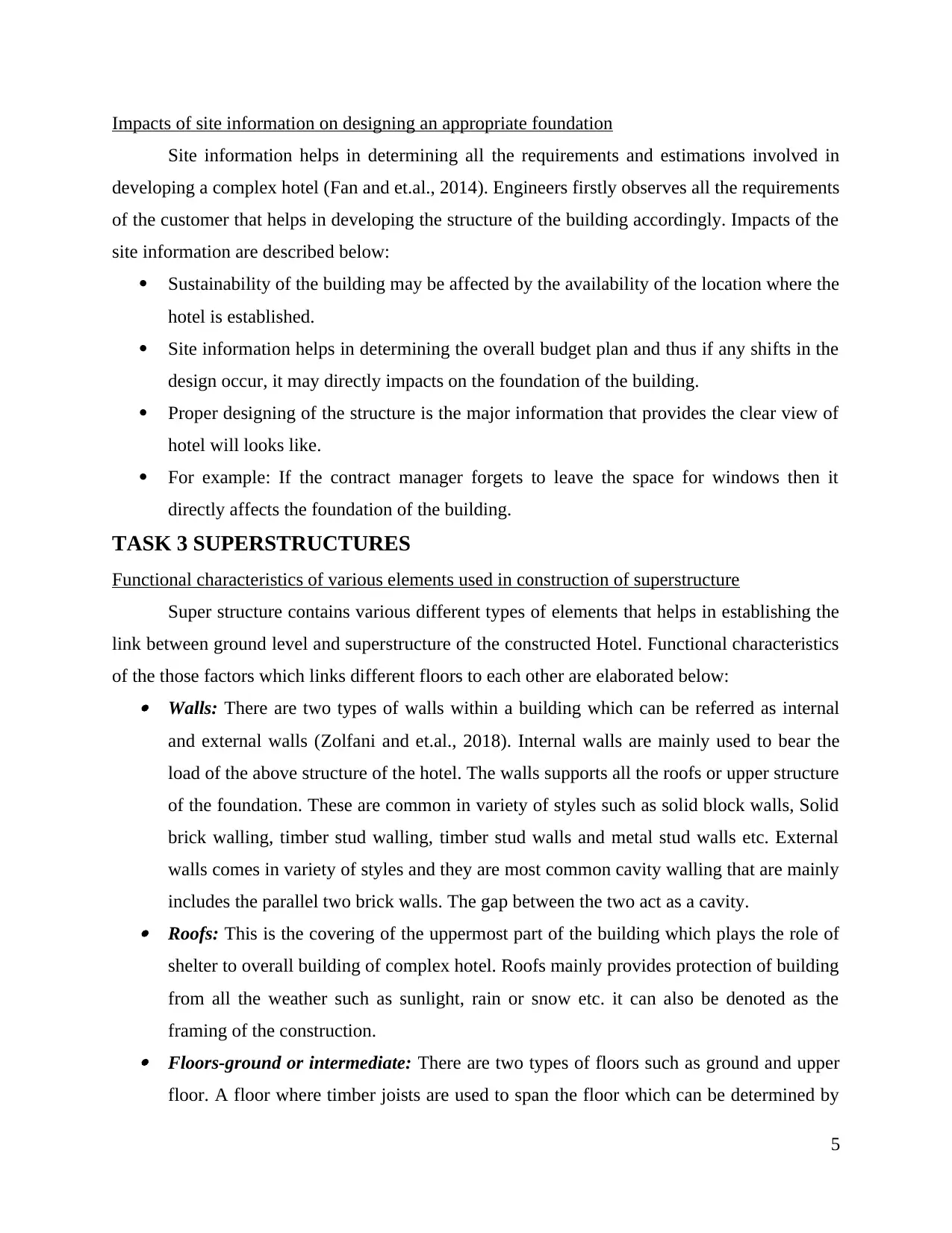
Impacts of site information on designing an appropriate foundation
Site information helps in determining all the requirements and estimations involved in
developing a complex hotel (Fan and et.al., 2014). Engineers firstly observes all the requirements
of the customer that helps in developing the structure of the building accordingly. Impacts of the
site information are described below:
Sustainability of the building may be affected by the availability of the location where the
hotel is established.
Site information helps in determining the overall budget plan and thus if any shifts in the
design occur, it may directly impacts on the foundation of the building.
Proper designing of the structure is the major information that provides the clear view of
hotel will looks like.
For example: If the contract manager forgets to leave the space for windows then it
directly affects the foundation of the building.
TASK 3 SUPERSTRUCTURES
Functional characteristics of various elements used in construction of superstructure
Super structure contains various different types of elements that helps in establishing the
link between ground level and superstructure of the constructed Hotel. Functional characteristics
of the those factors which links different floors to each other are elaborated below: Walls: There are two types of walls within a building which can be referred as internal
and external walls (Zolfani and et.al., 2018). Internal walls are mainly used to bear the
load of the above structure of the hotel. The walls supports all the roofs or upper structure
of the foundation. These are common in variety of styles such as solid block walls, Solid
brick walling, timber stud walling, timber stud walls and metal stud walls etc. External
walls comes in variety of styles and they are most common cavity walling that are mainly
includes the parallel two brick walls. The gap between the two act as a cavity. Roofs: This is the covering of the uppermost part of the building which plays the role of
shelter to overall building of complex hotel. Roofs mainly provides protection of building
from all the weather such as sunlight, rain or snow etc. it can also be denoted as the
framing of the construction. Floors-ground or intermediate: There are two types of floors such as ground and upper
floor. A floor where timber joists are used to span the floor which can be determined by
5
Site information helps in determining all the requirements and estimations involved in
developing a complex hotel (Fan and et.al., 2014). Engineers firstly observes all the requirements
of the customer that helps in developing the structure of the building accordingly. Impacts of the
site information are described below:
Sustainability of the building may be affected by the availability of the location where the
hotel is established.
Site information helps in determining the overall budget plan and thus if any shifts in the
design occur, it may directly impacts on the foundation of the building.
Proper designing of the structure is the major information that provides the clear view of
hotel will looks like.
For example: If the contract manager forgets to leave the space for windows then it
directly affects the foundation of the building.
TASK 3 SUPERSTRUCTURES
Functional characteristics of various elements used in construction of superstructure
Super structure contains various different types of elements that helps in establishing the
link between ground level and superstructure of the constructed Hotel. Functional characteristics
of the those factors which links different floors to each other are elaborated below: Walls: There are two types of walls within a building which can be referred as internal
and external walls (Zolfani and et.al., 2018). Internal walls are mainly used to bear the
load of the above structure of the hotel. The walls supports all the roofs or upper structure
of the foundation. These are common in variety of styles such as solid block walls, Solid
brick walling, timber stud walling, timber stud walls and metal stud walls etc. External
walls comes in variety of styles and they are most common cavity walling that are mainly
includes the parallel two brick walls. The gap between the two act as a cavity. Roofs: This is the covering of the uppermost part of the building which plays the role of
shelter to overall building of complex hotel. Roofs mainly provides protection of building
from all the weather such as sunlight, rain or snow etc. it can also be denoted as the
framing of the construction. Floors-ground or intermediate: There are two types of floors such as ground and upper
floor. A floor where timber joists are used to span the floor which can be determined by
5
Paraphrase This Document
Need a fresh take? Get an instant paraphrase of this document with our AI Paraphraser
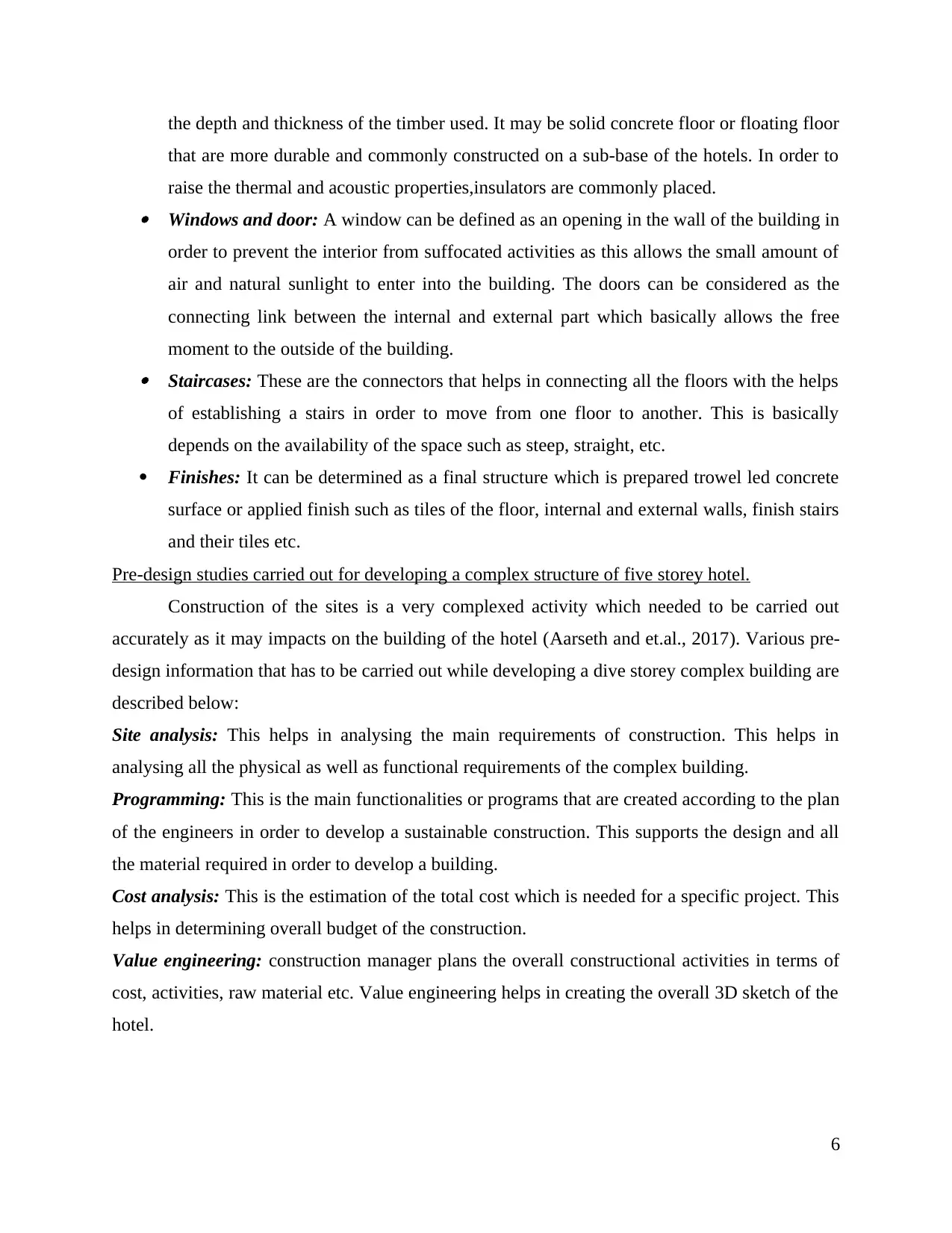
the depth and thickness of the timber used. It may be solid concrete floor or floating floor
that are more durable and commonly constructed on a sub-base of the hotels. In order to
raise the thermal and acoustic properties,insulators are commonly placed. Windows and door: A window can be defined as an opening in the wall of the building in
order to prevent the interior from suffocated activities as this allows the small amount of
air and natural sunlight to enter into the building. The doors can be considered as the
connecting link between the internal and external part which basically allows the free
moment to the outside of the building. Staircases: These are the connectors that helps in connecting all the floors with the helps
of establishing a stairs in order to move from one floor to another. This is basically
depends on the availability of the space such as steep, straight, etc.
Finishes: It can be determined as a final structure which is prepared trowel led concrete
surface or applied finish such as tiles of the floor, internal and external walls, finish stairs
and their tiles etc.
Pre-design studies carried out for developing a complex structure of five storey hotel.
Construction of the sites is a very complexed activity which needed to be carried out
accurately as it may impacts on the building of the hotel (Aarseth and et.al., 2017). Various pre-
design information that has to be carried out while developing a dive storey complex building are
described below:
Site analysis: This helps in analysing the main requirements of construction. This helps in
analysing all the physical as well as functional requirements of the complex building.
Programming: This is the main functionalities or programs that are created according to the plan
of the engineers in order to develop a sustainable construction. This supports the design and all
the material required in order to develop a building.
Cost analysis: This is the estimation of the total cost which is needed for a specific project. This
helps in determining overall budget of the construction.
Value engineering: construction manager plans the overall constructional activities in terms of
cost, activities, raw material etc. Value engineering helps in creating the overall 3D sketch of the
hotel.
6
that are more durable and commonly constructed on a sub-base of the hotels. In order to
raise the thermal and acoustic properties,insulators are commonly placed. Windows and door: A window can be defined as an opening in the wall of the building in
order to prevent the interior from suffocated activities as this allows the small amount of
air and natural sunlight to enter into the building. The doors can be considered as the
connecting link between the internal and external part which basically allows the free
moment to the outside of the building. Staircases: These are the connectors that helps in connecting all the floors with the helps
of establishing a stairs in order to move from one floor to another. This is basically
depends on the availability of the space such as steep, straight, etc.
Finishes: It can be determined as a final structure which is prepared trowel led concrete
surface or applied finish such as tiles of the floor, internal and external walls, finish stairs
and their tiles etc.
Pre-design studies carried out for developing a complex structure of five storey hotel.
Construction of the sites is a very complexed activity which needed to be carried out
accurately as it may impacts on the building of the hotel (Aarseth and et.al., 2017). Various pre-
design information that has to be carried out while developing a dive storey complex building are
described below:
Site analysis: This helps in analysing the main requirements of construction. This helps in
analysing all the physical as well as functional requirements of the complex building.
Programming: This is the main functionalities or programs that are created according to the plan
of the engineers in order to develop a sustainable construction. This supports the design and all
the material required in order to develop a building.
Cost analysis: This is the estimation of the total cost which is needed for a specific project. This
helps in determining overall budget of the construction.
Value engineering: construction manager plans the overall constructional activities in terms of
cost, activities, raw material etc. Value engineering helps in creating the overall 3D sketch of the
hotel.
6
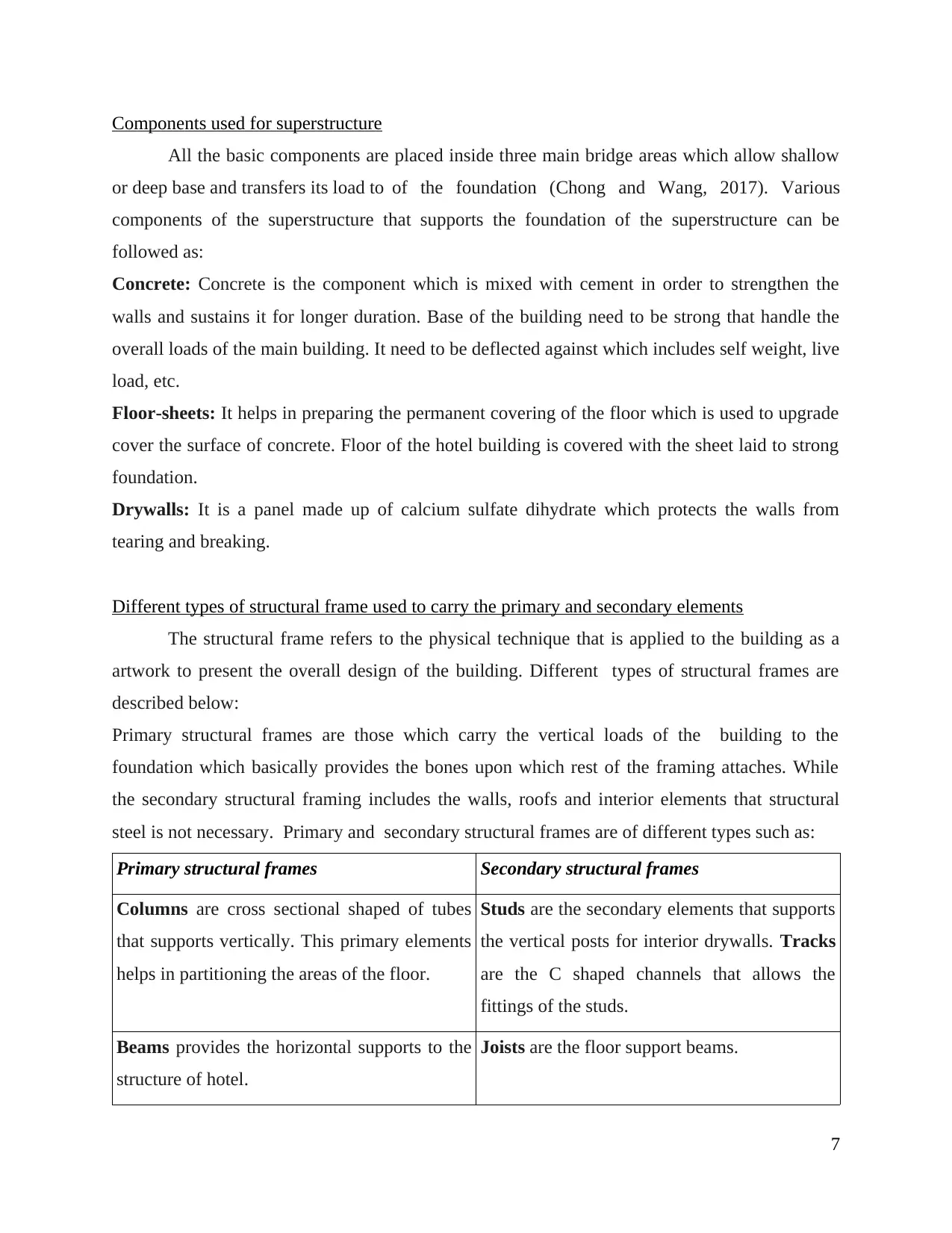
Components used for superstructure
All the basic components are placed inside three main bridge areas which allow shallow
or deep base and transfers its load to of the foundation (Chong and Wang, 2017). Various
components of the superstructure that supports the foundation of the superstructure can be
followed as:
Concrete: Concrete is the component which is mixed with cement in order to strengthen the
walls and sustains it for longer duration. Base of the building need to be strong that handle the
overall loads of the main building. It need to be deflected against which includes self weight, live
load, etc.
Floor-sheets: It helps in preparing the permanent covering of the floor which is used to upgrade
cover the surface of concrete. Floor of the hotel building is covered with the sheet laid to strong
foundation.
Drywalls: It is a panel made up of calcium sulfate dihydrate which protects the walls from
tearing and breaking.
Different types of structural frame used to carry the primary and secondary elements
The structural frame refers to the physical technique that is applied to the building as a
artwork to present the overall design of the building. Different types of structural frames are
described below:
Primary structural frames are those which carry the vertical loads of the building to the
foundation which basically provides the bones upon which rest of the framing attaches. While
the secondary structural framing includes the walls, roofs and interior elements that structural
steel is not necessary. Primary and secondary structural frames are of different types such as:
Primary structural frames Secondary structural frames
Columns are cross sectional shaped of tubes
that supports vertically. This primary elements
helps in partitioning the areas of the floor.
Studs are the secondary elements that supports
the vertical posts for interior drywalls. Tracks
are the C shaped channels that allows the
fittings of the studs.
Beams provides the horizontal supports to the
structure of hotel.
Joists are the floor support beams.
7
All the basic components are placed inside three main bridge areas which allow shallow
or deep base and transfers its load to of the foundation (Chong and Wang, 2017). Various
components of the superstructure that supports the foundation of the superstructure can be
followed as:
Concrete: Concrete is the component which is mixed with cement in order to strengthen the
walls and sustains it for longer duration. Base of the building need to be strong that handle the
overall loads of the main building. It need to be deflected against which includes self weight, live
load, etc.
Floor-sheets: It helps in preparing the permanent covering of the floor which is used to upgrade
cover the surface of concrete. Floor of the hotel building is covered with the sheet laid to strong
foundation.
Drywalls: It is a panel made up of calcium sulfate dihydrate which protects the walls from
tearing and breaking.
Different types of structural frame used to carry the primary and secondary elements
The structural frame refers to the physical technique that is applied to the building as a
artwork to present the overall design of the building. Different types of structural frames are
described below:
Primary structural frames are those which carry the vertical loads of the building to the
foundation which basically provides the bones upon which rest of the framing attaches. While
the secondary structural framing includes the walls, roofs and interior elements that structural
steel is not necessary. Primary and secondary structural frames are of different types such as:
Primary structural frames Secondary structural frames
Columns are cross sectional shaped of tubes
that supports vertically. This primary elements
helps in partitioning the areas of the floor.
Studs are the secondary elements that supports
the vertical posts for interior drywalls. Tracks
are the C shaped channels that allows the
fittings of the studs.
Beams provides the horizontal supports to the
structure of hotel.
Joists are the floor support beams.
7
⊘ This is a preview!⊘
Do you want full access?
Subscribe today to unlock all pages.

Trusted by 1+ million students worldwide
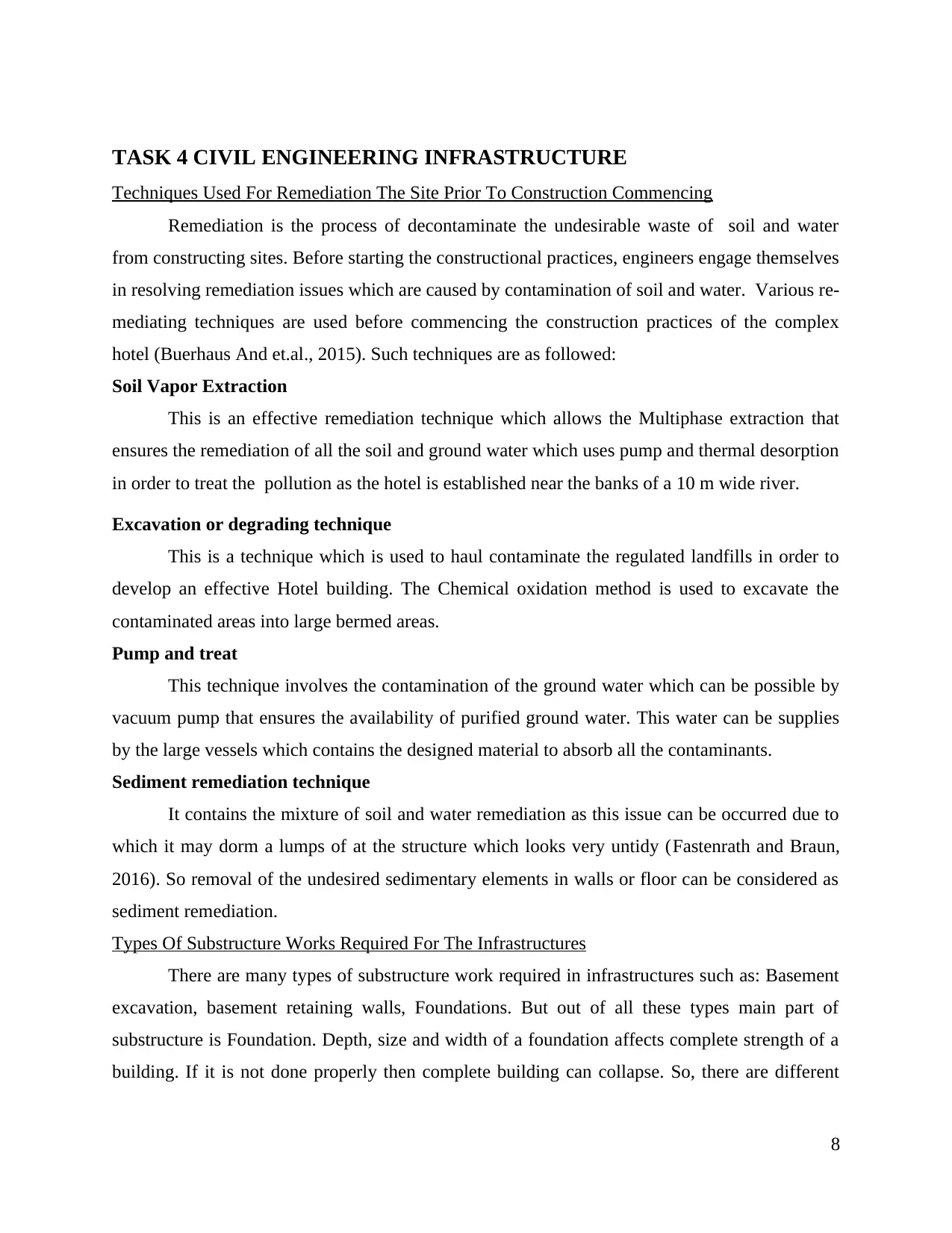
TASK 4 CIVIL ENGINEERING INFRASTRUCTURE
Techniques Used For Remediation The Site Prior To Construction Commencing
Remediation is the process of decontaminate the undesirable waste of soil and water
from constructing sites. Before starting the constructional practices, engineers engage themselves
in resolving remediation issues which are caused by contamination of soil and water. Various re-
mediating techniques are used before commencing the construction practices of the complex
hotel (Buerhaus And et.al., 2015). Such techniques are as followed:
Soil Vapor Extraction
This is an effective remediation technique which allows the Multiphase extraction that
ensures the remediation of all the soil and ground water which uses pump and thermal desorption
in order to treat the pollution as the hotel is established near the banks of a 10 m wide river.
Excavation or degrading technique
This is a technique which is used to haul contaminate the regulated landfills in order to
develop an effective Hotel building. The Chemical oxidation method is used to excavate the
contaminated areas into large bermed areas.
Pump and treat
This technique involves the contamination of the ground water which can be possible by
vacuum pump that ensures the availability of purified ground water. This water can be supplies
by the large vessels which contains the designed material to absorb all the contaminants.
Sediment remediation technique
It contains the mixture of soil and water remediation as this issue can be occurred due to
which it may dorm a lumps of at the structure which looks very untidy (Fastenrath and Braun,
2016). So removal of the undesired sedimentary elements in walls or floor can be considered as
sediment remediation.
Types Of Substructure Works Required For The Infrastructures
There are many types of substructure work required in infrastructures such as: Basement
excavation, basement retaining walls, Foundations. But out of all these types main part of
substructure is Foundation. Depth, size and width of a foundation affects complete strength of a
building. If it is not done properly then complete building can collapse. So, there are different
8
Techniques Used For Remediation The Site Prior To Construction Commencing
Remediation is the process of decontaminate the undesirable waste of soil and water
from constructing sites. Before starting the constructional practices, engineers engage themselves
in resolving remediation issues which are caused by contamination of soil and water. Various re-
mediating techniques are used before commencing the construction practices of the complex
hotel (Buerhaus And et.al., 2015). Such techniques are as followed:
Soil Vapor Extraction
This is an effective remediation technique which allows the Multiphase extraction that
ensures the remediation of all the soil and ground water which uses pump and thermal desorption
in order to treat the pollution as the hotel is established near the banks of a 10 m wide river.
Excavation or degrading technique
This is a technique which is used to haul contaminate the regulated landfills in order to
develop an effective Hotel building. The Chemical oxidation method is used to excavate the
contaminated areas into large bermed areas.
Pump and treat
This technique involves the contamination of the ground water which can be possible by
vacuum pump that ensures the availability of purified ground water. This water can be supplies
by the large vessels which contains the designed material to absorb all the contaminants.
Sediment remediation technique
It contains the mixture of soil and water remediation as this issue can be occurred due to
which it may dorm a lumps of at the structure which looks very untidy (Fastenrath and Braun,
2016). So removal of the undesired sedimentary elements in walls or floor can be considered as
sediment remediation.
Types Of Substructure Works Required For The Infrastructures
There are many types of substructure work required in infrastructures such as: Basement
excavation, basement retaining walls, Foundations. But out of all these types main part of
substructure is Foundation. Depth, size and width of a foundation affects complete strength of a
building. If it is not done properly then complete building can collapse. So, there are different
8
Paraphrase This Document
Need a fresh take? Get an instant paraphrase of this document with our AI Paraphraser
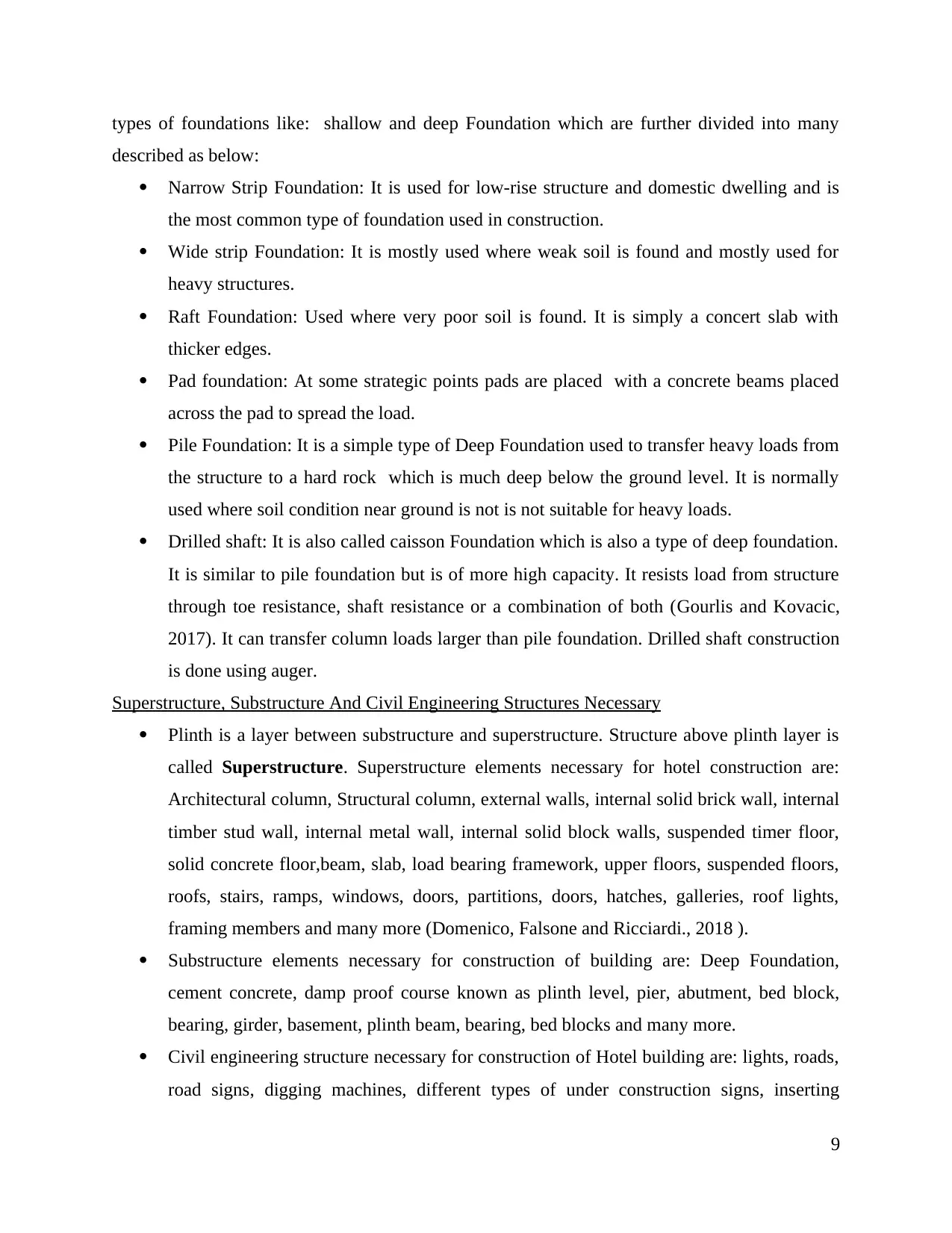
types of foundations like: shallow and deep Foundation which are further divided into many
described as below:
Narrow Strip Foundation: It is used for low-rise structure and domestic dwelling and is
the most common type of foundation used in construction.
Wide strip Foundation: It is mostly used where weak soil is found and mostly used for
heavy structures.
Raft Foundation: Used where very poor soil is found. It is simply a concert slab with
thicker edges.
Pad foundation: At some strategic points pads are placed with a concrete beams placed
across the pad to spread the load.
Pile Foundation: It is a simple type of Deep Foundation used to transfer heavy loads from
the structure to a hard rock which is much deep below the ground level. It is normally
used where soil condition near ground is not is not suitable for heavy loads.
Drilled shaft: It is also called caisson Foundation which is also a type of deep foundation.
It is similar to pile foundation but is of more high capacity. It resists load from structure
through toe resistance, shaft resistance or a combination of both (Gourlis and Kovacic,
2017). It can transfer column loads larger than pile foundation. Drilled shaft construction
is done using auger.
Superstructure, Substructure And Civil Engineering Structures Necessary
Plinth is a layer between substructure and superstructure. Structure above plinth layer is
called Superstructure. Superstructure elements necessary for hotel construction are:
Architectural column, Structural column, external walls, internal solid brick wall, internal
timber stud wall, internal metal wall, internal solid block walls, suspended timer floor,
solid concrete floor,beam, slab, load bearing framework, upper floors, suspended floors,
roofs, stairs, ramps, windows, doors, partitions, doors, hatches, galleries, roof lights,
framing members and many more (Domenico, Falsone and Ricciardi., 2018 ).
Substructure elements necessary for construction of building are: Deep Foundation,
cement concrete, damp proof course known as plinth level, pier, abutment, bed block,
bearing, girder, basement, plinth beam, bearing, bed blocks and many more.
Civil engineering structure necessary for construction of Hotel building are: lights, roads,
road signs, digging machines, different types of under construction signs, inserting
9
described as below:
Narrow Strip Foundation: It is used for low-rise structure and domestic dwelling and is
the most common type of foundation used in construction.
Wide strip Foundation: It is mostly used where weak soil is found and mostly used for
heavy structures.
Raft Foundation: Used where very poor soil is found. It is simply a concert slab with
thicker edges.
Pad foundation: At some strategic points pads are placed with a concrete beams placed
across the pad to spread the load.
Pile Foundation: It is a simple type of Deep Foundation used to transfer heavy loads from
the structure to a hard rock which is much deep below the ground level. It is normally
used where soil condition near ground is not is not suitable for heavy loads.
Drilled shaft: It is also called caisson Foundation which is also a type of deep foundation.
It is similar to pile foundation but is of more high capacity. It resists load from structure
through toe resistance, shaft resistance or a combination of both (Gourlis and Kovacic,
2017). It can transfer column loads larger than pile foundation. Drilled shaft construction
is done using auger.
Superstructure, Substructure And Civil Engineering Structures Necessary
Plinth is a layer between substructure and superstructure. Structure above plinth layer is
called Superstructure. Superstructure elements necessary for hotel construction are:
Architectural column, Structural column, external walls, internal solid brick wall, internal
timber stud wall, internal metal wall, internal solid block walls, suspended timer floor,
solid concrete floor,beam, slab, load bearing framework, upper floors, suspended floors,
roofs, stairs, ramps, windows, doors, partitions, doors, hatches, galleries, roof lights,
framing members and many more (Domenico, Falsone and Ricciardi., 2018 ).
Substructure elements necessary for construction of building are: Deep Foundation,
cement concrete, damp proof course known as plinth level, pier, abutment, bed block,
bearing, girder, basement, plinth beam, bearing, bed blocks and many more.
Civil engineering structure necessary for construction of Hotel building are: lights, roads,
road signs, digging machines, different types of under construction signs, inserting
9
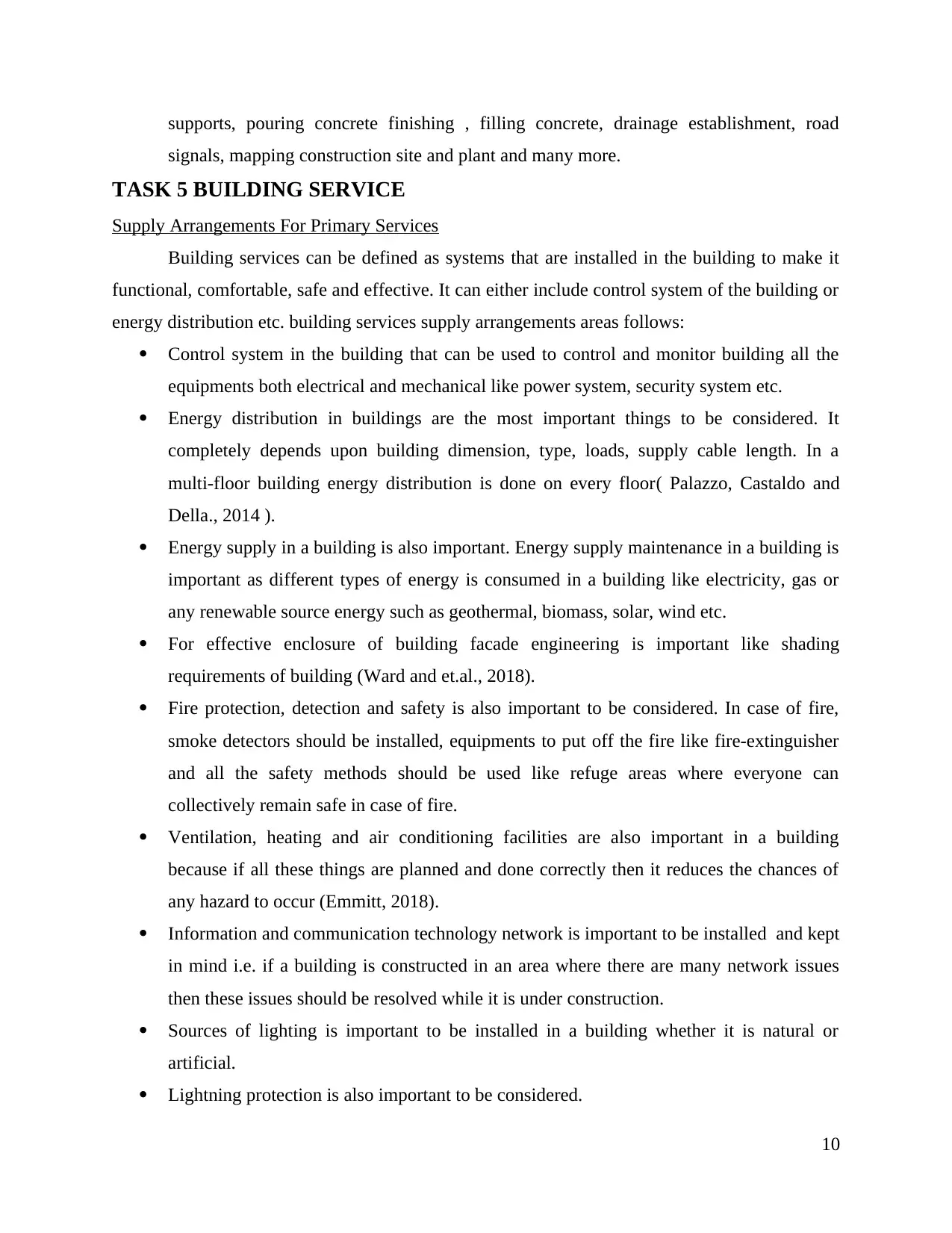
supports, pouring concrete finishing , filling concrete, drainage establishment, road
signals, mapping construction site and plant and many more.
TASK 5 BUILDING SERVICE
Supply Arrangements For Primary Services
Building services can be defined as systems that are installed in the building to make it
functional, comfortable, safe and effective. It can either include control system of the building or
energy distribution etc. building services supply arrangements areas follows:
Control system in the building that can be used to control and monitor building all the
equipments both electrical and mechanical like power system, security system etc.
Energy distribution in buildings are the most important things to be considered. It
completely depends upon building dimension, type, loads, supply cable length. In a
multi-floor building energy distribution is done on every floor( Palazzo, Castaldo and
Della., 2014 ).
Energy supply in a building is also important. Energy supply maintenance in a building is
important as different types of energy is consumed in a building like electricity, gas or
any renewable source energy such as geothermal, biomass, solar, wind etc.
For effective enclosure of building facade engineering is important like shading
requirements of building (Ward and et.al., 2018).
Fire protection, detection and safety is also important to be considered. In case of fire,
smoke detectors should be installed, equipments to put off the fire like fire-extinguisher
and all the safety methods should be used like refuge areas where everyone can
collectively remain safe in case of fire.
Ventilation, heating and air conditioning facilities are also important in a building
because if all these things are planned and done correctly then it reduces the chances of
any hazard to occur (Emmitt, 2018).
Information and communication technology network is important to be installed and kept
in mind i.e. if a building is constructed in an area where there are many network issues
then these issues should be resolved while it is under construction.
Sources of lighting is important to be installed in a building whether it is natural or
artificial.
Lightning protection is also important to be considered.
10
signals, mapping construction site and plant and many more.
TASK 5 BUILDING SERVICE
Supply Arrangements For Primary Services
Building services can be defined as systems that are installed in the building to make it
functional, comfortable, safe and effective. It can either include control system of the building or
energy distribution etc. building services supply arrangements areas follows:
Control system in the building that can be used to control and monitor building all the
equipments both electrical and mechanical like power system, security system etc.
Energy distribution in buildings are the most important things to be considered. It
completely depends upon building dimension, type, loads, supply cable length. In a
multi-floor building energy distribution is done on every floor( Palazzo, Castaldo and
Della., 2014 ).
Energy supply in a building is also important. Energy supply maintenance in a building is
important as different types of energy is consumed in a building like electricity, gas or
any renewable source energy such as geothermal, biomass, solar, wind etc.
For effective enclosure of building facade engineering is important like shading
requirements of building (Ward and et.al., 2018).
Fire protection, detection and safety is also important to be considered. In case of fire,
smoke detectors should be installed, equipments to put off the fire like fire-extinguisher
and all the safety methods should be used like refuge areas where everyone can
collectively remain safe in case of fire.
Ventilation, heating and air conditioning facilities are also important in a building
because if all these things are planned and done correctly then it reduces the chances of
any hazard to occur (Emmitt, 2018).
Information and communication technology network is important to be installed and kept
in mind i.e. if a building is constructed in an area where there are many network issues
then these issues should be resolved while it is under construction.
Sources of lighting is important to be installed in a building whether it is natural or
artificial.
Lightning protection is also important to be considered.
10
⊘ This is a preview!⊘
Do you want full access?
Subscribe today to unlock all pages.

Trusted by 1+ million students worldwide
1 out of 17
Related Documents
Your All-in-One AI-Powered Toolkit for Academic Success.
+13062052269
info@desklib.com
Available 24*7 on WhatsApp / Email
![[object Object]](/_next/static/media/star-bottom.7253800d.svg)
Unlock your academic potential
Copyright © 2020–2025 A2Z Services. All Rights Reserved. Developed and managed by ZUCOL.





